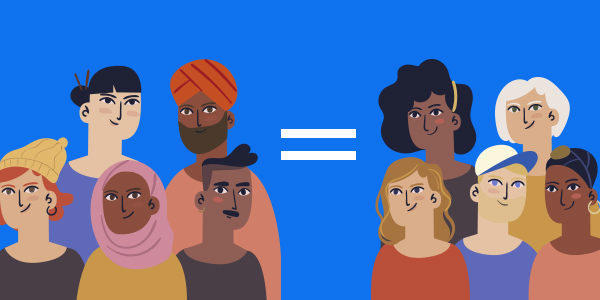Diversity, Equity, and Inclusion, commonly abbreviated as DE&I, is a term that has been the talk of the town for a while now. In practice, though, it’s a lot more than just another workplace term or HR strategy.
Companies that show a higher level of diversity are 70% more likely to capture a new market.
69% of executives feel diversity and inclusion is an important matter.
Inclusive organizations show a 2.3x higher cash flow per employee over a 3-year long period.
These statistics are some among the ocean of research and expertise on why DE&I deserves your attention. But, while we might all recognize its importance, understanding, and implementing it efficiently can often be a challenge. If done right, though, it can reward you with higher levels of employee engagement and positive work culture. Read on to help us walk you through how to get this right.
Diversity. Equity. Inclusion. What do these words mean?
Made up of three different words, the term DE&I can often mean different things for various organizations. Since these words are often used interchangeably, and the after-effects can be disastrous, here’s an attempt to simplify what the three words mean.
Diversity
At its simplest form, diversity means variety and relies on the understanding that each individual is unique and hence is a valuable resource. Diversity cuts across gender, ethnicity/race, religion, culture/nationality, age, sexual orientation, disabilities (both visible and invisible), socioeconomic background, and educational qualifications.
Within an organization, diversity seeks to create a safe space for every employee or candidate regardless of where they come from.
Equity
Not the same as equality; equity focuses on fairness and justice. Under equity, every person has access to equal opportunity as per their needs and is treated fairly. Equity pays special attention to removing any barriers an individual may face to ensure every group’s full participation.
Within an organization, equity extends to a lot more than equal pay and concentrates on ensuring that no employee remains disadvantaged and devoid of growth.
Inclusion
As the word suggests, inclusion is to do with creating an inclusive environment and is intrinsically linked to diversity. Inclusion helps remove all barriers and discrimination and ensures that those with marginalized identities are given access to all the opportunities. As Verna Myers famously puts it, “Diversity is being invited to the party; inclusion is being asked to dance.”
Within an organization, inclusion ensures the diverse people hired by an organization are not left out of anything and are not forced to engage in covering where one hides the parts of their identity that makes them different and are given an environment that urges them to stay.
Equity v/s Equality: One of these things is not like the other

Don’t get fooled by how similar these two words look. They’re fairly different in meaning.
Equality is concerned with ensuring everyone is treated in the same way. It ensures everyone is given the same opportunities, access to the same resources, and treated equally. Equity, on the other hand, is concerned with ensuring everyone is treated with fairness and justice. It makes sure every individual is given the opportunities and resources they need.
Equity works on the concept of positive discrimination. It focuses on giving more to those who need more than equality, where an individual is given what everyone else is provided regardless of their individual needs. It is important to remember that while equity cannot be achieved through equality, equality can be achieved through equity.
As an organization, those that strive for equality might not take into consideration the need for equity. If you extend the same benefits to everyone, regardless of their gender, socioeconomic background, race, etc., then what you’re dishing out is equality and not equity. The needs of a pregnant person with a whole family that is dependent on them are very different from an individual who has only themselves to look after. In order to ensure that such differences are factored in, organizations need to concentrate on equity over equality.
How to ensure your DE&I initiatives work?

You could have the most genius diversity, equity and inclusion strategy on paper, but none of that will translate into real action unless certain aspects are taken care of. Here are a few tips on how you can make it work.
Set a goal, collect data, and examine it
Before implementing a DE&I strategy, set a goal that you want it to achieve. Constantly track this goal and maybe even compare it with how far other organizations have come. Try aligning these goals with your company values and ensure that you set realistic goals. Try setting a vision for your company’s DE&I program and regularly measure it to see what has been achieved and how much is left to do. Taking a data-centric approach can ensure your DE&I initiatives do not keep running if they’re not working and can also help you understand what exactly needs to be changed.
Loop in your leadership
Your leadership is the face of the organization and also the backbone. Looping leadership ensures you have their support and get the right kind of funding that you need to make your DE&I initiatives a success. Managers must also be trained to look out for bias and be kept informed of any such initiatives. They’re often the first touchpoint for anyone who feels they’re being discriminated against. Both leaders and managers also come in handy when setting an example via exclusive behaviour, checking their own biases, and ensuring that best work wins.
Be prepared with alternative complaint portals
Retaliation is a major problem with any complaints that employees make against discrimination or harassment of any kind. Since retaliation often causes long-term damage to people’s careers, it can deter complainants, thereby leading to discrimination that remains rampant and unreported. Setting up other options such as Employee Assistance Plans (EAPs), ombuds offices, and other alternative dispute resolution systems can help break this vicious cycle and ensure your DE&I reaches the intended goal.
Check for biased technology usage
Technology, especially hiring solutions, can often reproduce and even increase the level of bias within an organization. It is essential to ensure that the HR service delivery software you choose for screening, hiring, and evaluating candidates is built on data that is not biased against any groups whatsoever. If the software itself weeds out people based on their gender, race, socioeconomic background, or any other such criteria, your DE&I strategy is bound to fall flat on its face.
On an ending note, it is essential to remember that DE&I is an ongoing process and cannot be attained through a single program or initiative. It is also nearly impossible to say how long it will take for organizations to become truly diverse, inclusive, and equal. It is essential to continually check ourselves against all our biases and be open to unlearning. As long as you genuinely care about removing all systemic biases within an organization, there’s nothing that can stop you from succeeding in doing the same.







2 Comments